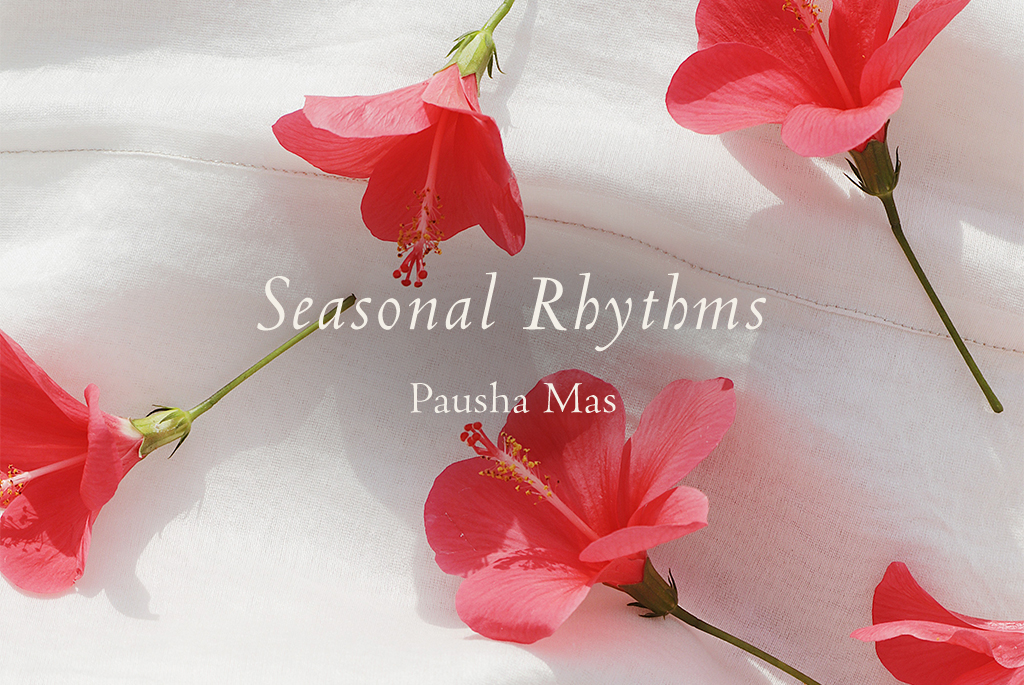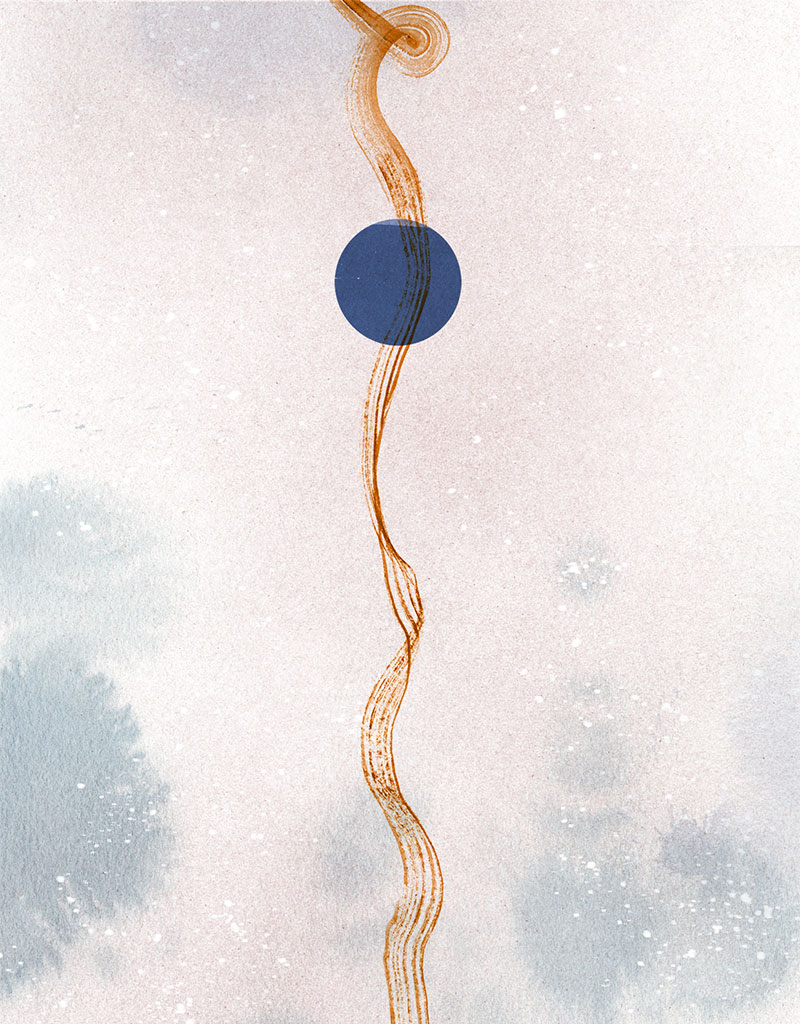Nilakshi Sharma

Pausha, the last month of Hemanta rtu brings with it the coldest days of the year. The riverbanks are shrouded in mist, the wind is bitingly cold, the skies are grey and the Sun appears in the sky as a pale gold disk, leached of all its warmth and energy. Pausha is a month of absence – of warmth, of colour, of bustling energy; in this month a quiet stillness seems to descend upon the earth, which is being blanketed by snow in higher altitudes.
Warming Rituals
Warmth is what we seek in all forms in the month of Pausha. The traditional diets, foods and seeds recommended for winters are all warming. In Ayurveda even wine is recommended in moderation to increase our metabolism.
- Tillkut: Tillkut or Sesame seed Laddoos are a typical winter food – warming, rich in iron and calcium, this is an ideal winter food.
Ingredients: Til (Sesame seeds): 250 grams + Jaggery powder: 250 grams + Ghee: 1 to 2 tsp Desi Ghee
Process: Dry roast the Sesame seeds in a wide pan over medium heat. Stir continuously until seeds start turning brown and give off a nutty aroma. Remove from heat immediately. Be careful to not let the seeds burn as that makes them taste bitter. Cool the seeds before grinding them into a coarse powder. Warm the ghee. Now mix together the Sesame seed powder, Jaggery powder and the warm ghee. Coat hands with a bit of ghee and shape the mixture into small round laddoos. This needs to be done while the mixture is still warm. If desired, the freshly shaped laddoos can be further rolled in a plate of Sesame seeds for coating. Now set the balls on a tray to air dry for a few hours before storing them in airtight containers.
Exercising the body in this time of Kapha dominance is vital to keep the flow of prana and the circulation of blood in the body energetic. Another way of keeping your circulation energetic is Abhyanga.
- Abhyanga: Regular self-massage with gently warmed oil is highly beneficial in this month. Mustard oil is a good choice as it is a heavy, warming oil. Sesame seed oil or medicated Ayurvedic oils are also good choices. Avoid lighter, cooling oils such as Coconut or Almond oil. Gently warm the oil and massage the body in slow, long strokes. Bathe after thirty minutes with warm water. Avoid soap – you can use traditional cleansing grains such as ubtans instead.
Despite all precautions, at this time of the year most people experience mucous-related ailments – cold, congestion and phlegm. Traditional tisanes and practices can also help us deal with the ailments typical of this wet and cold season.
- Heating Winter Tisane: A warming winter tisane, this concoction enhances digestive fire, helps with better elimination and better circulation.
Ingredients: 1 Tsp Ginger powder I 1 ½ Tsp Cinnamon powder I ¼ tsp Cardamom powder. Mix all the powders and store in an airtight container. To make the tisane: Steep 1 teaspoon of the mix in a cup of boiling hot water. Let stand for 5 to 7 minutes. Drink warm after adding a little Honey.
- Clearing Excess Kapha: This is an Ayurvedic home remedy recommended by Dr Lad. It helps in preventing and clearing excess Kapha from our respiratory tracts, allowing us to steer clear of Kapha-related imbalances such as congestion.
Ingredients: ½ tsp Ginger powder + ½ tsp Ground Mustard powder + 1 tsp Honey. Mix all three together into a paste and have twice a day. Sip hot water along with it if desired.
Nasal Care
Keeping the nasal passage clear and healthy is also important. Two traditional practices focused on nasal health are Nasya and Neti. Both practices are traditionally recommended for dealing with Kapha-related imbalances such as congestion. But more than that, they are also recommended for a host of other benefits such as clearer breathing, strengthening of vision and clarity of mind.
- Nasya: The practice of Nasya involves applying an Ayurvedic herbal oil to the nasal passages. This helps in keeping them lubricated and soothes any irritation. It can also help rejuvenate the nasal membranes and keep the nasal passages clear of dust and allergens. Nasya is not recommended during pregnancy and menstruation.
- Neti: The practice of a daily nasal rinse cleanses and moistens the nasal passages. It also helps in clearing up excess mucous, dust, dirt, etc. Essentially it consists of running warm saline water through the nasal passages. Natural mineral or sea salt is recommended. You will need a proper Neti pot for this practice. Please reach out to a trained Yoga & Ayurvedic practitioner to learn how to perform Neti.
Of Pauses & Prayers
The still quietness of the month is the time of being indoors, of seeking shelter and warmth. But most of all Pausha is the month for remembrance and for turning inwards in our practices.
Meditation: This winter month is ideal for meditation and meditative practices such as journal writing. Tratak or flame meditation, mantra meditation, or any kind of spiritual or meditation practice that grounds us, centres us and allows us to grow spiritually is a good choice for this time of the year.
Pausha Amavasya: Traditionally, Pausha mas is seen as the time of ancestors. It is thought they are closer to us at this time than any other and thus, we honour them and seek their blessings with prayers and ritual practices. Of these, the most important day is the New Moon or Amavasya of Pausha. Fasting, a ritual bath in a sacred river such as the Ganges, prayers and giving of grains and clothes as daan (charity) are some of the traditional practices followed on this Amavasya. Perhaps the two simplest practices that one can follow are lighting a diya in remembrance of our loved ones and of offering water to the Sun first thing in the morning; take water in a copper pot, add red flowers to it and then offer it to the Sun. This year Pausha Amavasya will fall on Thursday, 11 January, 2024.
Pausha Lakshmi: One classical description of Hemanta rtu focuses on the fact that while the world is shrouded in mist and blanketed by snow, and the Sun is pale, all the “light and colour of the season seems to have taken refuge in the ripe rice-plants, which shine like gold”. Rice planted in the rainy season is harvested in November-December, i.e., Pausha. This bounty of the earth; which comes to fill our granaries just as we enter the coldest fallow season, when the earth will be laden with frost and snow; is one that was once celebrated as a blessing of abundance and worshipped as Pausha Lakshmi or Saubhagya Lakshmi.
There are few remnants left of this traditional agrarian festival; in parts of Bengal the ritual worship of Pausha/ Dhan Lakshmi is celebrated as ‘Lokhi Pujo’. The goddess is worshipped not as an idol but as ‘Lokhi Shora’ – an earthen disc upon which the goddess Lakshmi is drawn, or hand painted. Often even this disc is replaced by earthen pots filled with paddy that are then worshipped as Dhan Lakshmi. Other rituals include the making of ‘kola ghacher bhela’ – boats carved from the stem of Banana trees. Perhaps these signify the successful storage of harvested grain – which in earlier times would have been a form of wealth. Even the bhog or prasad offered to the goddess is typically vegetarian and consists of grains, nuts and seeds.
Shakambari Purnima: The month of Pusha ends with a Full Moon celebration of an oft forgotten goddess – Shakambari Devi, “She who brings forth vegetation”. Legend has it that after a century of persistent drought, the earth was ravaged by famine and devoid of vegetation. In desperation gods and men alike beseeched the Great Goddess – Shakti, for help. Shakti answered the prayers by manifesting upon earth as Shakambari Devi. For nine days and nine nights her body sprouted vegetation to regenerate the earth. She sublimated her body into the flora and forests that feed and sustain life. These nine days and nights were once celebrated as Shakambari Navratri. And culminated in Shakambari Purnima (25 January, 2024). The nine days of the green goddess begin on Thursday, 18 January 2024, the Ashtami which is also celebrated as Banada Ashtami, since one of the names of Shakambari is Banadevi (the goddess of the forest). In Karnataka this goddess is known as Banshankari Devi.
May the month of Pausha offer you the time to reflect, heal and nurture yourselves. And may the goddess of abundance bestow her grace upon your household.





